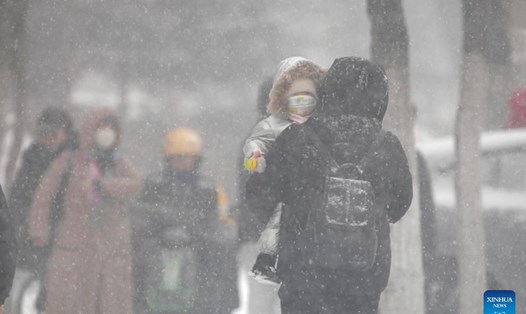The biggest November snowstorm in half a century blanketed the South Korean capital Seoul on November 27, grounding hundreds of flights, disrupting traffic and killing at least two people, AP reported.
The Korea Meteorological Agency said 20 to 26 centimeters of snow fell in northern Seoul and surrounding areas. It was the heaviest snowstorm Seoul has seen in November in 52 years. A storm on November 28, 1972, dumped 12 centimeters of snow.
One person died and four were injured in a five-vehicle crash in the town of Hongcheon, South Korea's Yonhap news agency reported.
In the town of Yangju, a tent-style garage collapsed and killed a person who was clearing snow, according to the Ministry of the Interior and Safety. The Gwangju provincial government said the heavy snow caused a temporary power outage in about 230 homes in the city of Gwangju, near Seoul.
The snowstorm blanketed much of South Korea, with central, eastern and southwestern regions recording about 10-28 cm of snow.
At least 317 flights were canceled or delayed at airports nationwide, while South Korean authorities also ordered about 90 ferries to stay in port. Hundreds of hiking trails were also closed amid the severe weather.
The Korea Weather Agency said snow fell in most parts of the country until noon on November 28.
Xinhua's latest weather report said that since November 26, many areas in Jilin and Heilongjiang provinces, northeastern China, have seen temperatures drop by more than 10 degrees Celsius due to the impact of cold air and snowstorms.
In Hegang City, Heilongjiang Province, the accumulated snowfall from 8:00 a.m. on November 26 to 8:00 a.m. on November 27 reached 49.7 mm, breaking the local historical record for one-day snowfall in November. The maximum snowfall was 48 cm in Hegang.
With up to 45 cm of snowfall, Heihe city broke its own record for snowfall since weather monitoring data began being kept in 1959.
Although snowfall in most areas of Heilongjiang has gradually eased, widespread snowfall is forecast to continue on November 28. Moreover, temperatures across Heilongjiang are expected to drop sharply.
According to the Heilongjiang weather bureau, the highest temperature in most areas of Heilongjiang dropped by 10 to 14 degrees Celsius on November 27.
The China Meteorological Administration (CMA) advised people to take necessary precautions during this cold spell, be vigilant against respiratory and cardiovascular diseases, and pay attention to safety when outdoors.
Across Heilongjiang Province, traffic police patrolled highways and national highways in both directions, checking for accumulated snow and ice on the roads.
Since the beginning of this week, the entire Inner Mongolia Autonomous Region in northern China has been hit by a severe cold wave, with temperatures plunging sharply. Minimum temperatures in most areas of central and eastern Inner Mongolia have dropped to around minus 13 degrees Celsius. In some places, temperatures have dropped to minus 18 degrees Celsius.
Xinhua's weather forecast said that from November 27-28, snowfall and even heavy snowstorms will hit northeastern Inner Mongolia, causing temperatures to drop by 4 to 6 degrees Celsius.









